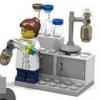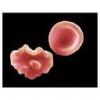Reputation Activity
-
 dmpollock got a reaction from CMCDCHI in Separate cells from plasma within 2 hoursI recommend NOT separating plasma from red cells. All that does is create an opportunity to mislabel the aliquot. I can tell you from having performed about 100 AABB and CAP inspections that the number of blood banks separating the plasma is definitely a minority.
dmpollock got a reaction from CMCDCHI in Separate cells from plasma within 2 hoursI recommend NOT separating plasma from red cells. All that does is create an opportunity to mislabel the aliquot. I can tell you from having performed about 100 AABB and CAP inspections that the number of blood banks separating the plasma is definitely a minority.
I was concerned about stability of our samples for PAT testing, so I made it a project for one of the MT students. I had her take 100 samples, run them on the ECHO on the day of collection, then rerun them on day 21. The comparison was made on ABO/Rh reactions (since I was concerned about using them for immediate spin crossmatch. This was prior to electronic crossmatch.) In 100% of the samples the ABO/Rh matched after storage. By running these on an analyzer it removed bias in the readings.
There was a slight drop in strength of the back type, but not enough to cause an ABO front type/back type discrepancy.
The specimens evaluated were all EDTA.
Of course, the procedure for testing must use samples that meet the specifications in the package inserts for the reagents being used. They typically will give a 7 day limit for testing refrigerated specimens without separating plasma. Be sure to check all the inserts, since the reagent cells might have a different time limit than the antisera.
-
 dmpollock got a reaction from mrdth5 in Satisfying TRM.40900 Blood/Tissue Sign-Out-transporter trainingWe have a clipboard in our signout area. Whoever picks up blood must read and sign the document as a one-time training event:
dmpollock got a reaction from mrdth5 in Satisfying TRM.40900 Blood/Tissue Sign-Out-transporter trainingWe have a clipboard in our signout area. Whoever picks up blood must read and sign the document as a one-time training event:
A copy of the file is attached. At the top left is a place for a logo or facility ID
Blood Transporter Training
By signing below I signify that I understand the following requirements for transporting blood components:
Blood must be transported directly to the area where it will be transfused (no side trips). Blood should never be put anywhere where it could be heated or cooled. If blood is issued in a cooler it must be kept in the cooler during transport. Do not leave blood unattended at any point. Hand blood over to an appropriate staff member immediately. Blood must be returned to the blood bank as soon as possible (no more than 30 minutes) if it is not going to be transfused. When the Blood Bank tech reads patient and blood information you must verbally read back the followingUnit number Medical Record Number Patient’s name. Blood Type of unit and patient.
Date
Printed Name
Signature
BloodIssueTransporterTraining2.doc
-
 dmpollock got a reaction from Sandy L in Separate cells from plasma within 2 hoursI recommend NOT separating plasma from red cells. All that does is create an opportunity to mislabel the aliquot. I can tell you from having performed about 100 AABB and CAP inspections that the number of blood banks separating the plasma is definitely a minority.
dmpollock got a reaction from Sandy L in Separate cells from plasma within 2 hoursI recommend NOT separating plasma from red cells. All that does is create an opportunity to mislabel the aliquot. I can tell you from having performed about 100 AABB and CAP inspections that the number of blood banks separating the plasma is definitely a minority.
I was concerned about stability of our samples for PAT testing, so I made it a project for one of the MT students. I had her take 100 samples, run them on the ECHO on the day of collection, then rerun them on day 21. The comparison was made on ABO/Rh reactions (since I was concerned about using them for immediate spin crossmatch. This was prior to electronic crossmatch.) In 100% of the samples the ABO/Rh matched after storage. By running these on an analyzer it removed bias in the readings.
There was a slight drop in strength of the back type, but not enough to cause an ABO front type/back type discrepancy.
The specimens evaluated were all EDTA.
Of course, the procedure for testing must use samples that meet the specifications in the package inserts for the reagents being used. They typically will give a 7 day limit for testing refrigerated specimens without separating plasma. Be sure to check all the inserts, since the reagent cells might have a different time limit than the antisera.
-
 dmpollock got a reaction from tbostock in Separate cells from plasma within 2 hoursI recommend NOT separating plasma from red cells. All that does is create an opportunity to mislabel the aliquot. I can tell you from having performed about 100 AABB and CAP inspections that the number of blood banks separating the plasma is definitely a minority.
dmpollock got a reaction from tbostock in Separate cells from plasma within 2 hoursI recommend NOT separating plasma from red cells. All that does is create an opportunity to mislabel the aliquot. I can tell you from having performed about 100 AABB and CAP inspections that the number of blood banks separating the plasma is definitely a minority.
I was concerned about stability of our samples for PAT testing, so I made it a project for one of the MT students. I had her take 100 samples, run them on the ECHO on the day of collection, then rerun them on day 21. The comparison was made on ABO/Rh reactions (since I was concerned about using them for immediate spin crossmatch. This was prior to electronic crossmatch.) In 100% of the samples the ABO/Rh matched after storage. By running these on an analyzer it removed bias in the readings.
There was a slight drop in strength of the back type, but not enough to cause an ABO front type/back type discrepancy.
The specimens evaluated were all EDTA.
Of course, the procedure for testing must use samples that meet the specifications in the package inserts for the reagents being used. They typically will give a 7 day limit for testing refrigerated specimens without separating plasma. Be sure to check all the inserts, since the reagent cells might have a different time limit than the antisera.
-
 dmpollock got a reaction from L106 in Separate cells from plasma within 2 hoursI recommend NOT separating plasma from red cells. All that does is create an opportunity to mislabel the aliquot. I can tell you from having performed about 100 AABB and CAP inspections that the number of blood banks separating the plasma is definitely a minority.
dmpollock got a reaction from L106 in Separate cells from plasma within 2 hoursI recommend NOT separating plasma from red cells. All that does is create an opportunity to mislabel the aliquot. I can tell you from having performed about 100 AABB and CAP inspections that the number of blood banks separating the plasma is definitely a minority.
I was concerned about stability of our samples for PAT testing, so I made it a project for one of the MT students. I had her take 100 samples, run them on the ECHO on the day of collection, then rerun them on day 21. The comparison was made on ABO/Rh reactions (since I was concerned about using them for immediate spin crossmatch. This was prior to electronic crossmatch.) In 100% of the samples the ABO/Rh matched after storage. By running these on an analyzer it removed bias in the readings.
There was a slight drop in strength of the back type, but not enough to cause an ABO front type/back type discrepancy.
The specimens evaluated were all EDTA.
Of course, the procedure for testing must use samples that meet the specifications in the package inserts for the reagents being used. They typically will give a 7 day limit for testing refrigerated specimens without separating plasma. Be sure to check all the inserts, since the reagent cells might have a different time limit than the antisera.
-
 dmpollock got a reaction from AMcCord in Separate cells from plasma within 2 hoursI recommend NOT separating plasma from red cells. All that does is create an opportunity to mislabel the aliquot. I can tell you from having performed about 100 AABB and CAP inspections that the number of blood banks separating the plasma is definitely a minority.
dmpollock got a reaction from AMcCord in Separate cells from plasma within 2 hoursI recommend NOT separating plasma from red cells. All that does is create an opportunity to mislabel the aliquot. I can tell you from having performed about 100 AABB and CAP inspections that the number of blood banks separating the plasma is definitely a minority.
I was concerned about stability of our samples for PAT testing, so I made it a project for one of the MT students. I had her take 100 samples, run them on the ECHO on the day of collection, then rerun them on day 21. The comparison was made on ABO/Rh reactions (since I was concerned about using them for immediate spin crossmatch. This was prior to electronic crossmatch.) In 100% of the samples the ABO/Rh matched after storage. By running these on an analyzer it removed bias in the readings.
There was a slight drop in strength of the back type, but not enough to cause an ABO front type/back type discrepancy.
The specimens evaluated were all EDTA.
Of course, the procedure for testing must use samples that meet the specifications in the package inserts for the reagents being used. They typically will give a 7 day limit for testing refrigerated specimens without separating plasma. Be sure to check all the inserts, since the reagent cells might have a different time limit than the antisera.
-
 dmpollock got a reaction from Malcolm Needs in Separate cells from plasma within 2 hoursI recommend NOT separating plasma from red cells. All that does is create an opportunity to mislabel the aliquot. I can tell you from having performed about 100 AABB and CAP inspections that the number of blood banks separating the plasma is definitely a minority.
dmpollock got a reaction from Malcolm Needs in Separate cells from plasma within 2 hoursI recommend NOT separating plasma from red cells. All that does is create an opportunity to mislabel the aliquot. I can tell you from having performed about 100 AABB and CAP inspections that the number of blood banks separating the plasma is definitely a minority.
I was concerned about stability of our samples for PAT testing, so I made it a project for one of the MT students. I had her take 100 samples, run them on the ECHO on the day of collection, then rerun them on day 21. The comparison was made on ABO/Rh reactions (since I was concerned about using them for immediate spin crossmatch. This was prior to electronic crossmatch.) In 100% of the samples the ABO/Rh matched after storage. By running these on an analyzer it removed bias in the readings.
There was a slight drop in strength of the back type, but not enough to cause an ABO front type/back type discrepancy.
The specimens evaluated were all EDTA.
Of course, the procedure for testing must use samples that meet the specifications in the package inserts for the reagents being used. They typically will give a 7 day limit for testing refrigerated specimens without separating plasma. Be sure to check all the inserts, since the reagent cells might have a different time limit than the antisera.


